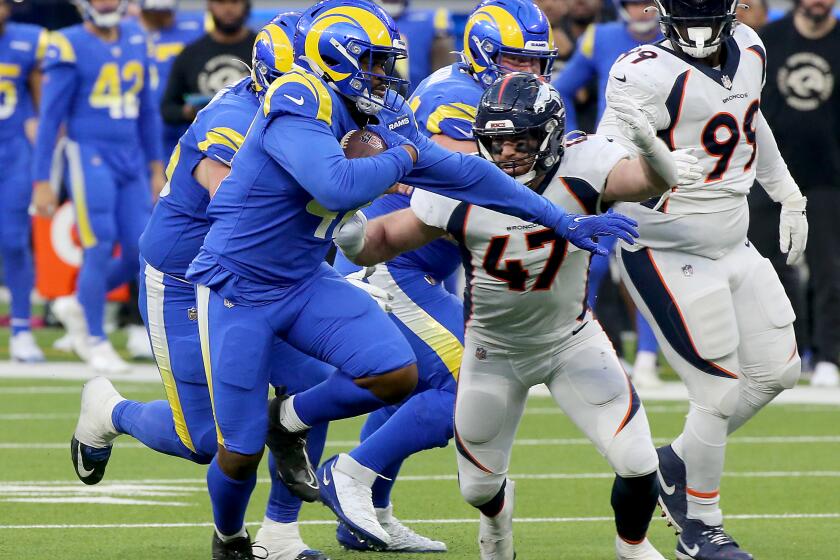The no-down lowdown
HOUSING prices may be taking a pause from their meteoric rise but that’s not making it any easier to lasso a house. Many home buyers still feel priced out of the market and despair of ever saving enough for a down payment. So an increasing number are turning to “zero-down” mortgages, which provide 100% financing.
Zero downs may not be a panacea for high housing prices, but they do eliminate a formidable barrier to owning a house, especially for first-time buyers. Still, only some borrowers qualify for the loans. And the mortgages may pose a special risk if housing prices unexpectedly head south and borrowers are left owing more than their houses are worth. But “zeroes” are increasingly popular because studies show that saving for a down payment is the biggest obstacle to homeownership.
Mike Cherashore recently used 100% financing to buy a two-bedroom, one-bath home with a guesthouse in Inglewood for $450,000. “I didn’t have the cash for a down payment, and I was looking at all kinds of creative ways of getting into a house,” said the pharmacist, who pays about $3,000 monthly for his mortgage.
Similarly, Elizabeth Gallegos didn’t think she could afford the $310,000 for a two-bedroom, one-bath house in Atwater until her real estate agent suggested a zero-down loan. Without such a mortgage, buying the house would have been “impossible,” according to the 31-year-old television-station employee, who pays $1,925 monthly on her mortgage.
Zero downs are a recent phenomenon. Until the 1990s, 100% financing programs were available only to military veterans or through special programs for some municipal employees and low-income buyers. The loans became available to other borrowers when Fannie Mae and other companies that buy mortgages in bulk from lenders began purchasing zero downs.
Of the estimated $1.5 trillion that Americans will spend this year to buy houses, 10% to 15% will be zero-down mortgages, compared with about 5% in 1993, according to Bill Dallas, board director of the California Mortgage Bankers Assn., a Sacramento-based trade group. (The figures do not include VA loans.)
Zero downs enable lenders to tap into a market of would-be home buyers who are desirable customers in every way except for savings, according to Doug Perry, senior vice president of Countrywide Home Loans.
“Zero downs created a market segment of individuals who were making a good living and were paying a fair amount of money on rent -- as much as it would cost them to buy a house -- and were not able to save up any money,” he said.
The wide availability of the loans reflects, among other factors, the increasing reliance of lenders on credit scores rather than income and payment history alone.
“Ten years ago, you would not have had 100% financing loan products,” said Jay Robertson, president of First Capital Mortgage of Santa Monica. “These types of products have helped the real estate market.”
Other than waiving the down payment, zero downs are the same as traditional mortgages. They are available for either 30 or 15 years at both fixed and adjustable interest rates. Some forms of zero down offer 103% financing, which includes the closing costs in the loan amount. A small number of loans impose a prepayment penalty, usually 1% of the borrowed amount.
For consumers, freedom from making down payments is a welcome change from the decades-old tradition of plunking down 10% or 20% in cash to qualify for a mortgage.
The rub is that most, if not all, zero-down lenders prefer customers with pristine credit. Very often, lenders will qualify only those borrowers with a credit score of about 700. Many lenders, in addition, will charge a “risk premium” to the interest rate, often between .25% and .50% of a percentage point, although for most buyers, that extra cost is “not so large as to discourage the transaction,” said Raphael Bostic, a housing economist and professor at USC’s Lusk Center for Real Estate.
Another limitation is that some lenders put a ceiling on the loan amount. Countrywide Home Loans, for example, has a $500,000 to $650,000 maximum, depending on the borrower’s credit rating. Still, the possibility of getting into a house now -- the median home price has been hovering around $407,000 for the last three months in Los Angeles County -- can make those limitations seem workable.
Inglewood home buyer Cherashore was cautious enough to reject the offer of an adjustable, zero-down loan. Many experts warn borrowers against adjustable loans, especially buyers who plan to stay in their homes for many years, because rates can rise unexpectedly. Cherashore eventually opted for a fixed-rate zero down.
“There are no disadvantages to me to having less equity in the house” than a conventional down payment, said Cherashore, who added that his “very conservative” accountant gave a thumbs-up to the deal.
Still, zero down does not mean no money, he said. When finalizing the sale, he put down $5,000 in a good-faith deposit and had to raise another $10,000 toward closing costs. Now the new Inglewood resident is working two jobs to defray those expenses.
Mortgage insurance is another potential problem with zero downs, because Fannie Mae and other mortgage buyers require home buyers to purchase insurance to protect lenders if a loan is for more than 80% of the home’s value.
Most lenders get around this rule, however, by packaging the zero down as two loans: an 80% mortgage combined with a 20% second loan or home-equity loan, usually at a higher interest rate. Gallegos, the Atwater home buyer, has a 5% interest rate on her 80% loan and a 9.5% rate on the second mortgage.
Yet another, more serious limitation is that not all home sellers will accept the zero down.
Some sellers or their agents may favor bids from buyers who will make down payments over those who will not. Rightly or wrongly, zero downs get the fish eye from some old-school home-sales agents who say they prefer to have buyers with more cash tied up in the sale.
“I don’t think there is anything wrong with them, but it is very hard to get a seller to accept this kind of buyer,” said Diana Walker, a sales agent in the Glendale office of Coldwell Banker.
The reason, she said, is that sellers perceive that a buyer who has the money to make a down payment is more likely to complete the sale. “If I have the same offer from a buyer with zero down and ... from someone else who is offering 20% down, there is no question in my mind who is the better risk,” Walker said.
She recalled a client who was attempting to buy a condominium with zero down -- with zero results. “She had perfect credit scores, but we could not get one seller to accept her offer of 0% down,” Walker said.
Beyond rejection by sellers with multiple offers, zero downs could backfire on borrowers who experience a string of bad luck, real estate professionals say. In a worst-case scenario, a home buyer loses her job and her income. Her house, meanwhile, has gone down in value, and she is paying more on the mortgage than the house is worth.
Her options are not pleasant: She can give the house back to the lender, damaging her credit severely, or sell the house for less than her mortgage and pay off the remainder herself.
In that worst-case situation, homeowners who made a 20% down payment might be better off, said Tim Doyle, director of government affairs at the Mortgage Bankers Assn. of America, a trade group in Washington.
Even if the house dips nearly 20% in value, he explained, the homeowner who made a down payment could still sell the house and could manage to pay off the entire mortgage and commissions. That would not be possible if the owner had borrowed 100% of the home’s price.
“That 20% of equity is your safety cushion,” Doyle said.
Bostic, the USC economist, said a zero down might make the most sense for a buyer who does not plan to live in the house for a long time in a fast-climbing housing market, “when most of the gain from selling the house comes from appreciation alone.”
In cases where buyers plan to live in the home for a long time, Bostic said, “it may be in the homeowner’s interest to start building in some equity, starting with a larger down payment.”
Morris Newman can be e-mailed at morris_newman@sbcglobal.net.






